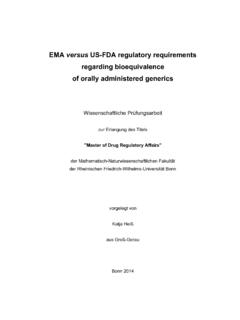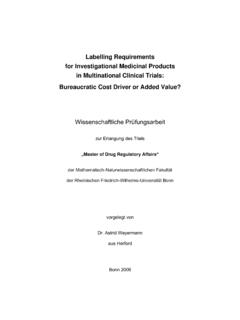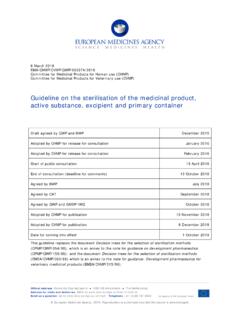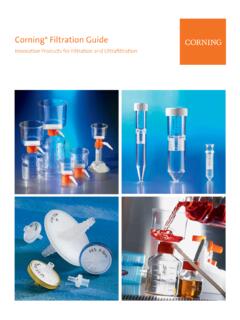Transcription of Basic Requirements For Aseptic Manufacturing Of Sterile ...
1 Basic Requirements For Aseptic Manufacturing Of Sterile Medicinal Products A Comparison Between Europe And USA Wissenschaftliche Pr fungsarbeit zur Erlangung des Titels Master of Drug Regulatory Affairs der Mathematisch-Naturwissenschaftlichen Fakult t der Rheinischen Friedrich-Wilhelms-Universit t Bonn vorgelegt von Dr. Gisela Greger aus Mannheim Bonn 2004 B Betreuer und erster Referent: Frau Dr. Rose Schraitle Zweiter Referent: Herr Wolfram Gering Table of Contents 1 1 1 1 Aseptic 2 Sterility Assurance Level, 2 Parametric 2 3 3 2 ISSUES UNDER 4 APPLICABILITY OF SPECIFICATION OF STERILITY TO PHARMACEUTICAL 4 In 4 In the 4 CURRENT GUIDELINES AND RECOMMENDATIONS - 4 SPECIAL ASPECTS IN Aseptic 8 Monitoring at Aseptic Manufacturing Sites - Environmental 8 Clean 8 Room 8 Risk of 10 Monitoring 10 Particle 10 Microbiological 12 Personnel.
2 Training and Entry to Clean 13 Cleaning and 13 Methods of Microbiological 14 Limits and Methods of 14 14 Surfaces (Room, Equipment).. 15 15 Identification of 17 Evaluation, Limits and 17 Sampling 18 Frequencies of Environmental 18 Incubation of the 20 Measures in Case of Exceeding 20 20 Aim of Environmental Monitoring - 20 Sterilisation 21 Sterilisation by Membrane 21 I Qualification of the Filter: Physical and Chemical Compatibility and Shedding of 21 Extractable Substances.
3 22 Adsorption of Substances .. 22 Microbiological Challenge - Bacterial Retaining Rate .. 22 Specification of filtration Time .. 22 Testing of the Integrity of the Filter .. 23 Support by the Supplier of the 23 Validation of Aseptic Filling Procedure with Media 23 Definition of Media Fill and Requirements of the 23 Microbiological Requirements on Validation of Media 24 Production 24 Environmental Control in Media 24 Air Condition System .. 26 Qualification of Personnel .. 26 Gas Supply 26 Cleaning and Sterilisation of 26 Necessity of Environmental 26 Extended Environmental Controls Versus Normal Environmental 27 Site Locations.
4 27 28 Additional 28 28 28 Qualification and Requalification of Media 29 Media fill and Detection of Specified 29 Cleaning, Heat Sterilisation and Depyrogenization of Container Closure 30 Description of Media 30 Choice of the Media 30 Media Fill and Filling 30 Preparation of Media 30 Worst Case 31 31 Number of Filled Units and Duration of the Filling 31 Duration of Process, Holding Times and Stopping 32 Selection of 32 Acceptance Criteria in Media 32 Warning Limits and Action 32 Action Limits / Procedure in the Case of Failed 33 Incubation 35 Checking of Growth 35 Growth Promoting Properties of the Used Nutrient 36 Overview of Requirements for Referenced Microorganisms in Checking of Growth 37 Inspection of the Filled 40 Identification of Microorganisms from Positive 40 Microbiological Testing in Media Fill - 40 3 RESULTS AND 42
5 RISK ANALYSIS (HACCP - HAZARD ANALYSIS AND CRITICAL CONTROL POINTS).. 44 4 CONCLUSION AND 46 5 48 6 49 IVList of Abbreviations ATCC American Type Culture Collection BSE Bovine Spongiform Encephalopathy CDER Center for Drug Evaluation And Research CFR Code of Federal Regulations CFU Colony Forming Units CIP/SIP Cleaning in Place / Sterilisation in Place CPMP Committee for Proprietary Medicinal Products DGHM Deutsche Gesellschaft f r Hygiene
6 Und Mikrobiologie EMEA European Medicines Evaluation Agency EP European Pharmacopoeia EU European Union FDA Food and Drug Administration FIP F d ration Int rnationale Pharmaceutique GMP Good Manufacturing Practice(s) HACCP Hazard Analysis and Critical Control Points HEPA High Efficiency Particulate Air IPC In Process Control ISO International Organisation for Standardisation OOS Out of Specification PDA Parenteral Drug Association Ph.
7 Eur European Pharmacopoeia PIC/S Pharmaceutical Inspection Convention QA Quality Assurance QWP Quality Working Party TOC Total Organic Carbon SAL Sterility Assurance Level SOP Standard Operating Procedure US United States USA United States of America USP United States Pharmacopoeia VPHP Vapor-Phase Hydrogen Peroxide WFI Water For Injection 11 Introduction In the early 1900s, the first parenteral drugs were manufactured on an industrial scale.
8 The need arose to find suitable sterilisation methods for heat sensitive products that could not be autoclaved in the final container. So called aseptically manufactured drug products have to be Sterile , although the sterilisation in the final container closure system is not possible. Since then the standards for Aseptic Manufacturing of medicinal drug products have become very high and clearly specified because of the nature of the pharmaceutical form and / or the manner in which they are administered (for example injections, infusions, pharmaceutical forms for the eyes such as eye drops etc.)
9 Parenteral products are intended to be nonpyrogenic too, additionally to the requirement to be Sterile . Medicinal drug products that do not meet the requirement to be Sterile / nonpyrogenic can otherwise cause severe harm or life-threatening health risk to the patient. In a world where global effects in the supply chain become more and more important, it is necessary to know the differences in the Requirements of the specific guidances and guidelines in the single markets of the world. Therefore this master thesis shall reveal the Basic Requirements of Aseptic Manufacturing of Sterile drug products for the EU and US market.
10 Knowledge of the differences in the Requirements is important to guarantee the quality of the products and their supply in due time for the single markets. To begin with, there is a short definition for example of sterility and Aseptic Manufacturing . Following it, is a summary of the Requirements for Aseptic Manufacturing (environmental monitoring, Sterile filtration and validation by media fill) along with the base of these Requirements , keeping in mind the differences between Europe and USA. The outlook will present a rational approach to the complete qualification (rooms, equipment, supply systems, materials etc.)








